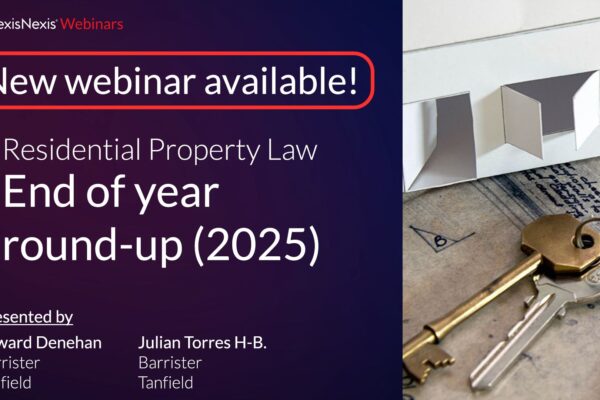Edward Denehan and Julian Torres-H-B have presented a detailed and insightful webinar
Bad drafting or giving effect to Parliament’s intention? BDW Trading Limited v Ardmore Construction Limited & Ors [2025] EWHC 434 (TCC)
![Bad drafting or giving effect to Parliament’s intention? BDW Trading Limited v Ardmore Construction Limited & Ors [2025] EWHC 434 (TCC)](https://tanfieldchambers.co.uk/wp-content/uploads/2025/03/shutterstock_1972642106-1800x1200-jpg.webp)
Sami Allan, a practising second six pupil at Tanfield, examines the recent decision in BDW Trading Limited v Ardmore Construction Limited & Ors [2025] EWHC 434 (TCC) in which the High Court undertook for the first time an examination of the circumstances in which an information order would be granted under s.132 of the Building Safety Act 2022 (“the Act”).
The facts
The Applicant, BDW, was the developer of 5 separate buildings which were constructed between 1999 and 2005 (“the Development”). As part of this process, BDW contracted with the First Respondent, Ardmore Construction Limited (“ACL”), to carry out the design and build of the Development. ACL was a subsidiary of the Second Respondent, Ardmore Construction Group Limited, who was itself a subsidiary of the Third Respondent, Admore Group Limited. All of the companies were owned by the parent-company, the Fourth Respondent, Ardmore Group Holdings Limited (collectively “R2-R4”).
Following the fire at Grenfell Tower in 2017, a number of fire safety and structural safety issues were discovered at each building on the Development. BDW accepted it was liable to carry out – at its own expense – the remedial works, but sought contributions from ACL on the basis that the defects on the Development were caused by ACL’s breach of duty during the construction process. In respect of one of the buildings, ACL were found liable during arbitration proceeding and an award was made in favour of BDW. However, ACL denied liability in relation to the remainder of the Development. BDW therefore sought to bring further proceedings against ACL.
BDW, after considering ACL’s accounts, concluded that ACL had insufficient funds to satisfy any liability. BDW therefore decided it would apply for a building liability order (under s.130 of the Act) against the entities “associated” with ACL. However, to do so, BDW required additional information about R2-R4. As such, BDW made an application for an information order against both ACL and R2-R4 (“the Application”).
The legal framework
Sections 130 and 132 of the Act provide so far as is material:
S.130(2): A “building liability order” is an order providing that any relevant liability (or any relevant liability of a specified description) of a body corporate (“the original body”) relating to a specified building is also –
(a) a liability of a specified body corporate, or
(b) a joint and several liability of two or more specified bodies corporate.
S.130(3): In this section “relevant liability” means a liability (whether arising before or after commencement) that is incurred –
(a) under the Defective Premises Act 1972 or section 38 of the Building Act 1984, or
(b) as a result of a building safety risk.
S.132(2): An “information order” is an order requiring a specified body corporate to give, by a specified time, specified information or documents relating to persons who are, or have at any time in a specified period been, associated with the body corporate.
S.132(3): An information order may be made only if it appears to the court –
(a) that the body corporate is subject to a relevant liability (within the meaning of section 130), and
(b) that it is appropriate to require the information or documents to be provided for the purpose of enabling the applicant (or the applicant and others) to make, or consider whether to make, an application for a building liability order.
The Act also contains two examples in the explanatory notes relating to the operation of s.130 and 132. The first example (“Example 1”) envisaged a situation where a freeholder could obtain a building liability order under s.130 of the Act against the parent company of a developer who had gone insolvent. The second example (“Example 2”) suggested that it was possible for the freeholder to obtain an information order under s.132 of the Act against the parent company of an insolvent developer.
The decision
HHJ Keyser KC (“the Judge”) dismissed the Application. While a building liability order could be made against an associated body under s.130 of the Act without a prior determination of a developer’s liability, an information order could only be made where the court has established that the respondent body corporate is subject to a relevant liability (ie a liability arising by reason of a building safety risk). This required a preliminary assessment by the Court hearing the relevant application.
Accordingly,
- ACL could not be subject to an information order as BDW had failed to establish that ACL were subject to a relevant liability; and
- R2-R4 could not be subject to an information order as s.132 of the Act only applies to entities who are subject to a relevant liability, and R2-R4 were not party to the contract concerning the Development.
In relation to (i), the Judge’s reasoning was that in order for a relevant liability to be established, BDW needed to show, on a preliminary basis that ACL were liable. As BDW had only adduced evidence to suggest that ACL might be liable, the Judge found that an information order could not be made.
As to (ii), the Judge observed that the wording of s.132 and the examples in the explanatory notes were simply incompatible. Following guidance from the Court of Appeal in Flora v Wakom (Heathrow) Ltd [2006] EWCA Civ 1103, the explanatory notes were merely an aid to construction, as opposed to a determinative indicator of Parliament’s intention. Consequently, the Judge held that an information order could not be made against R2-R4 because they were not subject to a relevant liability as required by s.132(3). In so holding, the Judge rejected the outcomes in both Example 1 and Example 2.
Both applications were therefore dismissed.
Comment
As a matter of statutory interpretation, the Judge’s conclusions are plainly correct. The relevant parts of the Act are clear as to the meaning of a relevant liability, and on the facts of the case none of the respondents could be said to be subject to such a liability.
However, the decision raises the question of whether it was truly Parliament’s intention for information orders to be so limited in scope. As made clear by the explanatory notes, the draftsman seems to have envisaged a scenario such as that which arose in the present case as being one in which an information order would be made. Further, the general intention behind the Act was to create a wider system of accountability in relation to building safety following the Grenfell disaster.
One must therefore wait to see if there is legislative push back to the restrictive scope of this decision.
You can find a copy of the judgment here.
Tanfield is a leading property set for issues relating to the Building Safety Act. You can view more information on the BSA Hub and on the Building Safety expertise page.
This content is provided free of charge for information purposes only. It does not constitute legal advice and should not be relied on as such. No responsibility for the accuracy and/or correctness of the information and commentary set out in the article, or for any consequences of relying on it, is assumed or accepted by any member of Tanfield or by Tanfield as a whole.






